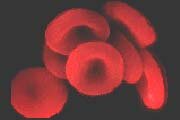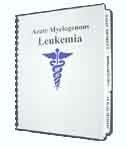 |
||
| HOME | ||
 |
||
| Acute Myelogenous Leukemia (AML) |
||
 |
||
| Other Leukemia Types (ALL / CLL / CML / HCL) |
||
 |
||
| Myelodysplastic Syndrome | ||
 |
||
| Symptoms and Diagnosis | ||
 |
||
| Leukemia Treatment Options | ||
 |
||
| " Chemotherapy | ||
 |
||
| " Blood Stem Cell Transplants | ||
 |
||
| " Radiation and Surgery | ||
 |
||
| " Chemo Side Effects | ||
 |
||
| " Clinical Trials Info | ||
 |
||
| " Coping with Leukemia | ||
 |
||
| " What to Ask Your Doctor | ||
 |
||
| Financial Assistance | ||
 |
||
| At Risk Jobs/Exposure | ||
 |
||
| Leukemia Resources | ||
 |
||
| Survivor's Story | ||
 |
||
| Leukemia News | ||
 |
||
|
Search for information:
|
||

|
Leukemia Cancer News - Return to Menu Source: North Shore-Long Island Jewish Health System MANHASSET, NY - 2005-02-18 - Scientists at the Institute for Medical Research at North Shore-LIJ have made a discovery that refutes two longstanding beliefs about the most common leukemia in the western hemisphere. Due to the relatively slow disease progression of chronic lymphocytic leukemia (CLL), doctors thought it was caused by a gradual accumulation of leukemia cells that could not die. The new findings, published online today in the Journal of Clinical Investigation, prove the exact opposite. The study will appear in the journal's March 2005 print issue. For decades, doctors and scientists believed that CLL was a static disease of long-lived white blood cells (lymphocytes) -- that the leukemia cells were both immortal and born at a slow rate, causing the slow rise in cell count over time. But researchers had been unable to find any problems with the leukemia cells' process of cell suicide, called apoptosis, a normal part of the cell life cycle for which all cells are programmed. This was a hint that perhaps the leukemia cells were not immortal. Using a clever study design that required subjects only to drink water and give blood samples, the research team, led by Nicholas Chiorazzi, MD, director and CEO of the Institute for Medical Research, found that the leukemia cells are born at a fast rate and do indeed die. The slow rise in the cell count over time can be attributed to the difference between the birth and death rates of the cells, according to the study. The scientists also found that there appeared to be a connection between poorer patient outcomes and the faster birth rates of the leukemia cells, regardless of the rate of cell death. "This particular finding may prove helpful in identifying patients who are at risk for worsening disease in advance of showing any clinical signs of deterioration," said Dr. Chiorazzi. He cautioned, however, that additional research is needed to establish its potential in guiding prognostic and treatment decisions. The study was small, examining 19 CLL patients. A larger trial is already underway to gain greater insights into the correlation and its potential clinical applications. The multicenter study is being led by Kanti Rai, MD, associate investigator with the Institute for Medical Research, chief of the Division of Hematology-Oncology at Long Island Jewish (LIJ) Medical Center and a world-renowned expert on CLL. More than 25 years ago, Dr. Rai developed a staging system for CLL that is still used today. Tahrun Wasil, MD, another well-known attending hematologist-oncologist at LIJ, is co-leading the trial with Dr. Rai. The study is being conducted in conjunction with the CLL Research Consortium (CRC), a multi-institutional project funded by the National Institutes of Health. The CRC includes LIJ Medical Center, University of California at San Diego, M.D. Anderson Cancer Center, Ohio State University, Johns Hopkins University, Dana Farber Cancer Institute, Mayo Clinic, and several sites that perform laboratory work alone, including the Burnham Institute and Sydney Kimmel Cancer Center. To test his theory that leukemia cells were not immortal, Dr. Chiorazzi used "heavy water" to track cell production. Heavy water is simply water that weighs more at the molecular level than normal. Among its many uses in the body, water gets incorporated into everyone's DNA. When a cell divides into two, the new cell gets an exact copy of the DNA from the original cell, so the incorporated heavy water serves as a tag that allows scientists to track the birth of new cells. The researchers gave individuals with CLL a small dose of heavy water -- about two ounces -- every day over the course of 12 weeks, enough time for the cells to incorporate a sufficient amount into their DNA. From blood samples, they calculated the birth and death rates of leukemia cells. They found that CLL is very much a dynamic process composed of mortal cells that proliferate and die, often with a high turnover, and not a static disease in which leukemia cells slowly build up because they cannot die, as previously thought. ### About chronic lymphocytic leukemia (CLL) Currently incurable, CLL is a cancer in which a certain kind of white blood cell in the bone marrow becomes abnormal and then divides repeatedly, producing clones that replace normal white blood cells in the bone marrow. Older men are affected more greatly than any other demographic group. The disease follows one of two distinct paths. Some patients experience a benign course, show little or no symptoms and do not require chemotherapy. This group typically lives for about 24 years after diagnosis and dies with the disease, not because of it. CLL in other patients follows a more aggressive course, requiring treatment with chemotherapy. Yet despite treatment, individuals with the more aggressive form live on average for a total of only about six to eight years after diagnosis. Determining which path a patient will follow and whether to treat has been challenging for doctors. Recent research findings, including this new study, have shed light on potential new methods for prediction. About the Institute for Medical Research at North Shore-LIJ Located in Manhasset, NY, and part of the North Shore-Long Island Jewish (LIJ) Health System, the Institute for Medical Research is among the top five percent of institutions nationally that receive funding from the National Institutes of Health. Building on its strengths in immunology and inflammation, oncology and cell biology, human genetics, and neurodegenerative and psychiatric disorders, its goal is to understand the biological processes that underlie various diseases and translate this knowledge into new tools for diagnosis and treatment. Related News Stories Peptide Vaccine Can Produce Complete Remission In Myeloid Leukemia Patients (December 17, 2004) -- Researchers from The University of Texas M. D. Anderson Cancer Center are reporting the first study to show that vaccination with a peptide that is abnormally expressed on myeloid leukemia cells can ... > full story More Than Half Of Relapsed CLL Patients Respond To Two Biologics With Chemotherapy (December 16, 2004) -- Combining two biologic agents with chemotherapy forms a potent drug regimen that is showing promise in treating patients who have relapsed with the most common kind of leukemia, chronic lymphocytic ... > full story Small Gene Changes In Some Leukemia Patients May Explain Varying Responses To Chemotherapy (May 5, 2004) -- A new study provides evidence that may explain why some patients with chronic lymphocytic leukemia (CLL) are resistant to chemotherapy
|
|
|


